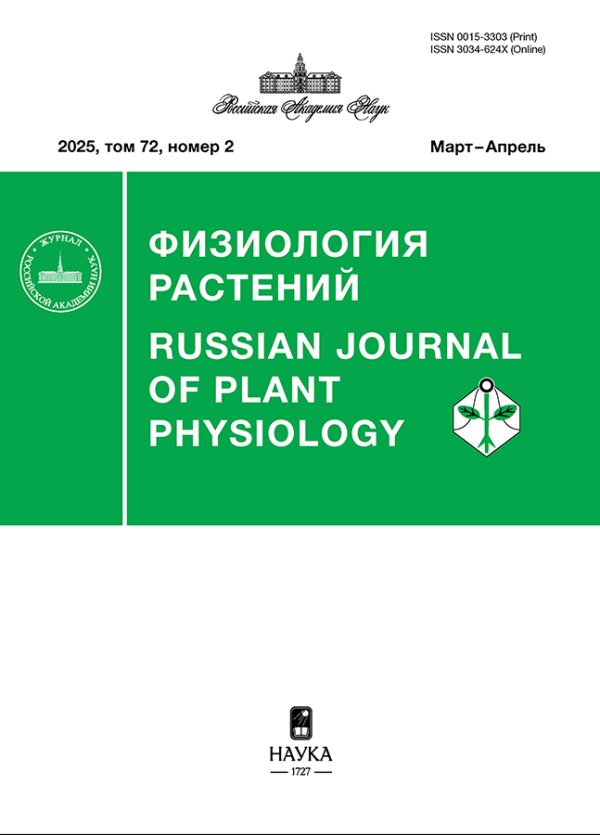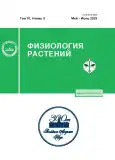The effect of low temperature and nitrogen starvation on the morphological and physiological characteristics of two strains of green microalgae of the genus Lobosphaera sp.
- Authors: Shibzukhova K.A.1, Chivkunova O.B.1, Lobakova E.S.1
-
Affiliations:
- Lomonosov Moscow State University
- Issue: Vol 70, No 3 (2023)
- Pages: 301-310
- Section: ЭКСПЕРИМЕНТАЛЬНЫЕ СТАТЬИ
- URL: https://journals.rcsi.science/0015-3303/article/view/130217
- DOI: https://doi.org/10.31857/S0015330322600772
- EDN: https://elibrary.ru/IBUSDD
- ID: 130217
Cite item
Full Text
Abstract
The effect of nitrogen starvation and, for the first time, low temperature, as well as their simultaneouseffect, on the physiology and ultrastructure of cells of microalgae of the genus Lobosphaera (Chlorophyta, Trebouxiophyceae) was studied. Nitrogen deficiency in both strains led to a decrease in the content ofchlorophyll by three times and an increase in the proportion of carotenoids by two times. A decrease in thecontent of both chlorophyll and carotenoids was observed at +10°C. The simultaneous effect of two factorsresulted in a threefold decrease in the chlorophyll content in NAMSU 924/2 and a sixfold decrease inNAMSU (CALU) 1497; the proportion of carotenoids in both strains decreased by 1.5–2 times. Data onultrastructural changes in cells of microalgae of the genus Lobosphaera under the influence of stress factorshave been obtained. A similar nature of the response in both strains to stress conditions was noted. Nitrogendeficiency led to the accumulation of numerous lipid droplets in the cytoplasm of cells along the cell wall. Long-term incubation on a nitrogen-free medium led to the filling of the entire volume of cells with lipiddroplets, disassembly of the membrane system of chloroplasts, that reduction in sizeand being locatedbetween densely lying lipid droplets. At low temperatures, the number of thylakoids decreased, while theinterthylakoid space and the size of chloroplasts increased. With simultaneous exposure to nitrogen starvation and low temperature, numerous lipid droplets accumulated, the number of thylakoids decreased, the interthylakoid space and the size of the chloroplast increased, which was noted under separate exposure to stress factors. The pyrenoid in both strains did not undergo significant changes in all cases.
About the authors
Karina A. Shibzukhova
Lomonosov Moscow State University
Author for correspondence.
Email: shibzuhovaKA@my.msu.ru
Russian Federation, Moscow
Olga B. Chivkunova
Lomonosov Moscow State University
Email: shibzuhovaKA@my.msu.ru
Russian Federation, Moscow
Elena S. Lobakova
Lomonosov Moscow State University
Email: shibzuhovaKA@my.msu.ru
Russian Federation, Moscow
References
- Borowitzka M.A. Microalgae for aquaculture: opportunities and constraints // J. Appl. Phycol. 1997. V. 9. P. 393. https://doi.org/10.1023/A:1007921728300
- Michalak I., Chojnacka K. Algal extracts: technology and advances // Eng. Life Sci. 2014. V. 14. P. 581. https://doi.org/10.1002/elsc.201400139
- Chojnacka K., Wieczorek P., Schroeder G., Michalak I. Algae biomass: characteristics and applications: towards algae-based products // Springer. 2018. V. 8. https://doi.org/10.1007/978-3-319-74703-3
- Соловченко А.Е. Физиологическая роль накопления нейтральных липидов эукариотическими микроводорослями при стрессах // Физиология растений. 2012. Т. 59. С. 192.
- Guschina I.A., Harwood J.L. Lipids and lipid metabolism in eukaryotic algae // Prog. Lipid Res. 2006. V. 45. P. 160. https://doi.org/10.1016/j.plipres.2006.01.001
- Morgan-Kiss R.M., Priscu J., Pocock T., Gudynaite-Savitch L., Norman P.A. Adaptation and acclimation of photosynthetic microorganisms to permanently cold environments // Microbiol. Mol. Biol. Rev. 2006. V. 70. P. 222. https://doi.org/10.1128/MMBR.70.1.222-252.2006
- Cohen Z., Khozin-Goldberg I., Adlerstein D., Bigogno C. The role of triacylglycerol as a reservoir of polyunsaturated fatty acids for the rapid production of chloroplastic lipids in certain microalgae // Biochem. Soc. Trans. 2000. V. 28. P. 740. https://doi.org/10.1042/bst0280740
- Spolaore P., Joannis-Cassan C., Duran E. and Isambert A. Commercial applications of microalgae // J. Biosci. Bioeng. 2006. V. 101. P. 87. https://doi.org/10.1042/bst0280740
- Ibañez E., Cifuentes A. Benefits of using algae as natural sources of functional ingredients // J. Sci. Food Agric. 2013. V. 93. P. 703. https://doi.org/10.1002/jsfa.6023
- Ścieszka S., Klewicka E. Algae in food: A general review // Crit. Rev. Food Sci. Nutr. 2019. V. 59. P. 3538. https://doi.org/10.1080/10408398.2018.1496319
- Mudimu O., Koopmann I.K., Rybalka N., Friedl T., Schulz R., Bilger W. Screening of microalgae and cyanobacteria strains for α-tocopherol content at different growth phases and the influence of nitrate reduction on α-tocopherol production // J. Appl. Phycol. 2017. V. 29. P. 2867. https://doi.org/10.1007/s10811-017-1188-1
- Мальцев Е.И., Мальцева И.А., Мальцева С.Ю., Куликовский М.С. Биотехнологический потенциал нового штамма Bracteacoccus bullatus (Sphaeropleales, Chlorophyta), перспективного продуцента омега-6 полиненасыщенных жирных кислот // Физиология растений. 2020. Т. 67. С. 96. https://doi.org/10.31857/S0015330320010121
- Stanier R.Y., Kunisawa R., Mandel M., Cohen-Bazire G. Purification and properties of unicellular blue-green algae (order Chroococcales) // Bacteriolog. Rev. 1971. V. 35. P. 171. https://doi.org/10.1128/br.35.2.171-205.1971
- Gorelova O.A., Baulina O.I., Solovchenko A.E., Chekanov K.A., Chivkunova O.B., Fedorenko T.A., Lobakova E.S. Similarity and diversity of the Desmodesmus spp. microalgae isolated from associations with White Sea invertebrates // Protoplasma. 2015. V. 252. P. 489. https://doi.org/10.1007/s00709-014-0694-0
- Reynolds E.S. The use of lead citrate of high pH as an electron opaque strain in electron microscopy // J. Cell. Biol. 1963. V. 17. P. 208. https://doi.org/10.1083/jcb.17.1.208
- Folch J., Lees M., Stanley G.S. A simple method for the isolation and purification of total lipids from animal tissues // J. Biol. Chem. 1957. V. 226. P. 497. https://doi.org/10.1016/S0021-9258(18)64849-5
- Kates M. Lipid extraction procedures. In Burden, R.H. and van Knippenberg, P.H. [Eds.] Techniques of lipidology: isolation, analysis and identification of lipids. 2nd edn. Elsevier Science, Amsterdam. 1986. P. 106.
- Wellburn A.R. The spectral determination of chlorophylls a and b, as well as total carotenoids, using various solvents with spectrophotometers of different resolution // J. Plant Physiol. 1994. V. 144. P. 307. https://doi.org/10.1016/S0176-1617(11)81192-2
- Steward F.C., Mühlethaler K. The structure and development of the cell-wall in the Valoniaceae as revealed by the electron microscope // Ann. Bot. 1953. V. 17. P. 295. https://doi.org/10.1093/oxfordjournals.aob.a083351
- Lichtenthaler H.K. Chlorophylls and carotenoids: pigments of photosynthetic biomembranes // Meth. Enzym. 1987. V. 148. P. 350. https://doi.org/10.1016/0076-6879(87)48036-1
- Cunningham Jr.F.X., Gantt E. Genes and enzymes of carotenoid biosynthesis in plants // Annu. Rev. Plant Biol. 1998. V. 49. P. 557. https://doi.org/10.1146/annurev.arplant.49.1.557
- Takaichi S. Carotenoids in algae: distributions, biosynthesis and functions // Marine drugs. 2011. V. 9. P. 1101. https://doi.org/10.3390/md9061101
- Borowitzka M. Algal biotechnology products and processes – matching science and economics // J. Appl. Phycol. 1992. V. 4. P. 267. https://doi.org/10.1007/BF02161212
- Bigogno C., Khozin-Goldberg I., Boussiba S., Vonshak A., Cohen Z. Lipid and fatty acid composition of the green oleaginous alga Parietochloris incisa, the richest plant source of arachidonic acid // Phytochem. 2002. V. 60. P. 497. https://doi.org/10.1016/S0031-9422(02)00100-0
- Leman J. Oleaginous microorganisms: an assessment of the potential // Adv. Appl. Microbiol. 1997. V. 43. P. 195. https://doi.org/10.1016/S0065-2164(08)70226-0
- Goodson C.R.R., Wang Z.T., Goodenough U. Structural correlates of cytoplasmic and chloroplast lipid body synthesis in Chlamydomonas reinhardtii and stimulation of lipid body production with acetate boost // Eukaryotic cell. 2011. V. 10. P. 1592. https://doi.org/10.1128/EC.05242-11
- Fan J., Andre C., Xu C. A chloroplast pathway for the de novo biosynthesis of triacylglycerol in Chlamydomonas reinhardtii // FEBS Letters. 2011. V. 585. P. 1985. https://doi.org/10.1016/j.febslet.2011.05.018
- Schüler L.M., Schulze P.S., Pereira H., Barreira L., León R., Varela J. Trends and strategies to enhance triacylglycerols and high-value compounds in microalgae // Algal Res. 2017. V. 25. P. 263. https://doi.org/10.1016/j.algal.2017.05.025
- Kugler A., Zorin B., Didi-Cohen S., Sibiryak M., Gorelova O., Ismagulova T., Kokabi K., Kumari P., Lukyanov A., Boussiba S., Solovchenko A., Khozin-Goldberg I. Long-chain polyunsaturated fatty acids in the green microalga Lobosphaera incisa contribute to tolerance to abiotic stresses // Plant Cell Physiol. 2019. V. 60. P. 1205. https://doi.org/10.1093/pcp/pcz013
- Merzlyak M.N., Chivkunova O.B., Gorelova O.A., Reshetnikova I.V., Solovchenko A.E., Khozin-Goldberg I., Cohen Z. Effect of nitrogen starvation on optical properties, pigments, and arachidonic acid content of the unicellular green alga Parietochloris incisa (Trebouxiophyceae, Chlorophyta) // J. Phycol. 2007. V. 43. P. 833. https://doi.org/10.1111/j.1529-8817.2007.00375.x
- Соловченко А.Е., Хозина-Голдберг И., Диди-Коэн Ш., Коэн Ц., Мерзляк М.Н. Влияние света и азотного голодания на содержание и состав каротиноидов зеленой водоросли Parietochloris incisa // Физиология растений. 2008. Т. 55. С. 507.
- Соловченко А.Е., Мерзляк М.Н., Чивкунова О.Б., Решетникова И.В., Хозина-Голдберг И., Диди-Коэн Ш., Коэн Ц. Влияние освещенности и азотного голодания на рост и накопление арахидоновой кислоты у одноклеточной водоросли Parietochloris incisa // Вестник Московского университета. Серия 16. Биология. 2008b. № 1. С. 49.
- Темралеева А.Д. Новые для почвенной альгофлоры России виды зеленых водорослей Bracteacoccus bullatus и B. occidentalis (Sphaeropleales, Chlorophyta) // Вопросы современной альгологии. 2018. №. 1. С. 14.
- Watanabe S., Hirabayashi S., Boussiba S., Cohen Z., Vonshak A., Richmond A. Parietochloris incisa comb. nov. (Trebouxiophyceae, Chlorophyta) // Phycolog. Res. 1996. V. 44. P. 107. https://doi.org/10.1111/j.1440-1835.1996.tb00383.x
- Khozin-Goldberg I., Shrestha P., Cohen Z. Mobilization of arachidonyl moieties from triacylglycerols into chloroplastic lipids following recovery from nitrogen starvation of the microalga Parietochloris incisa // BBA – Mol. Cell Biol. Lipids. 2005. V. 1738. P. 63. https://doi.org/10.1016/j.bbalip.2005.09.005
Supplementary files















